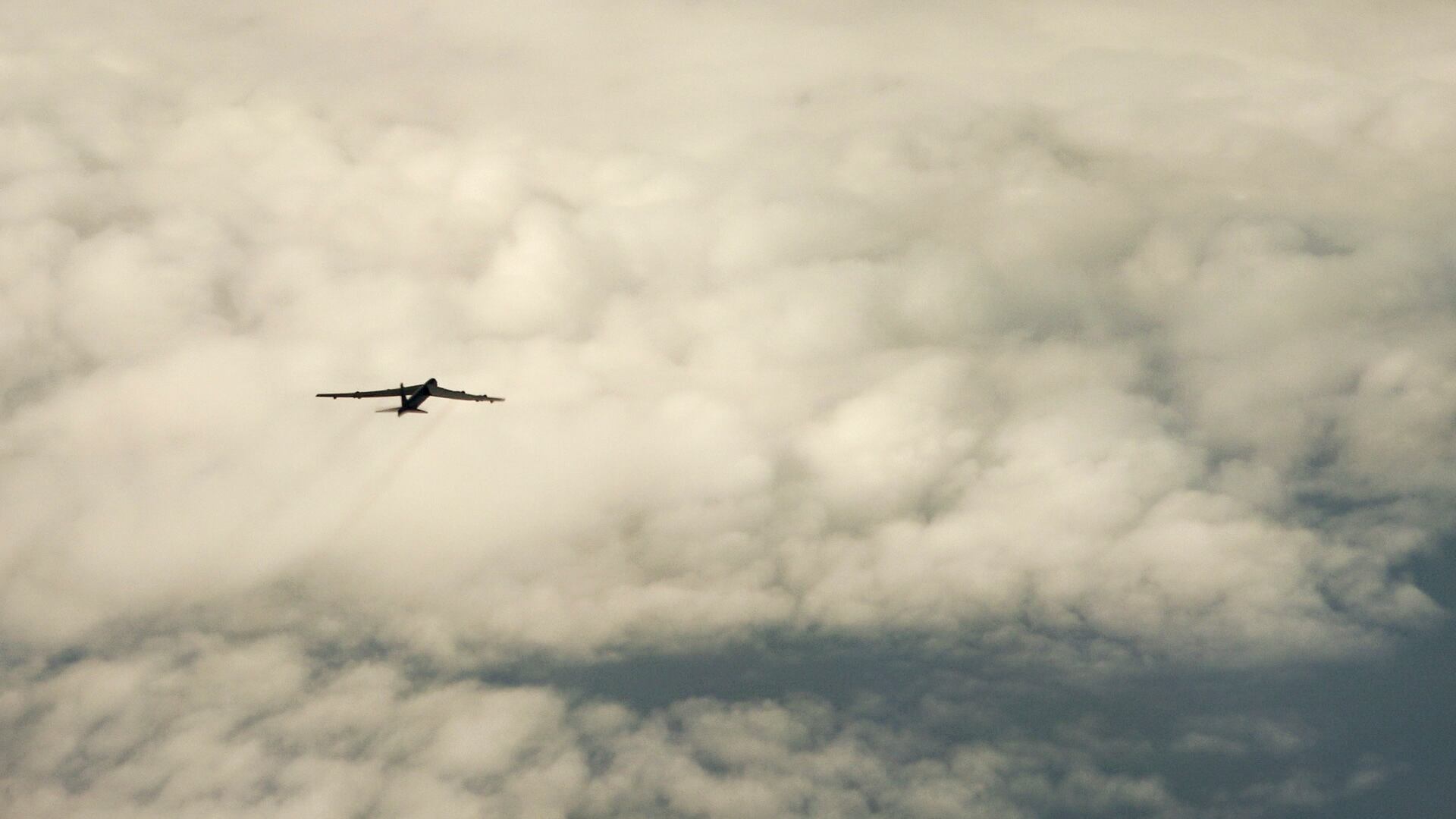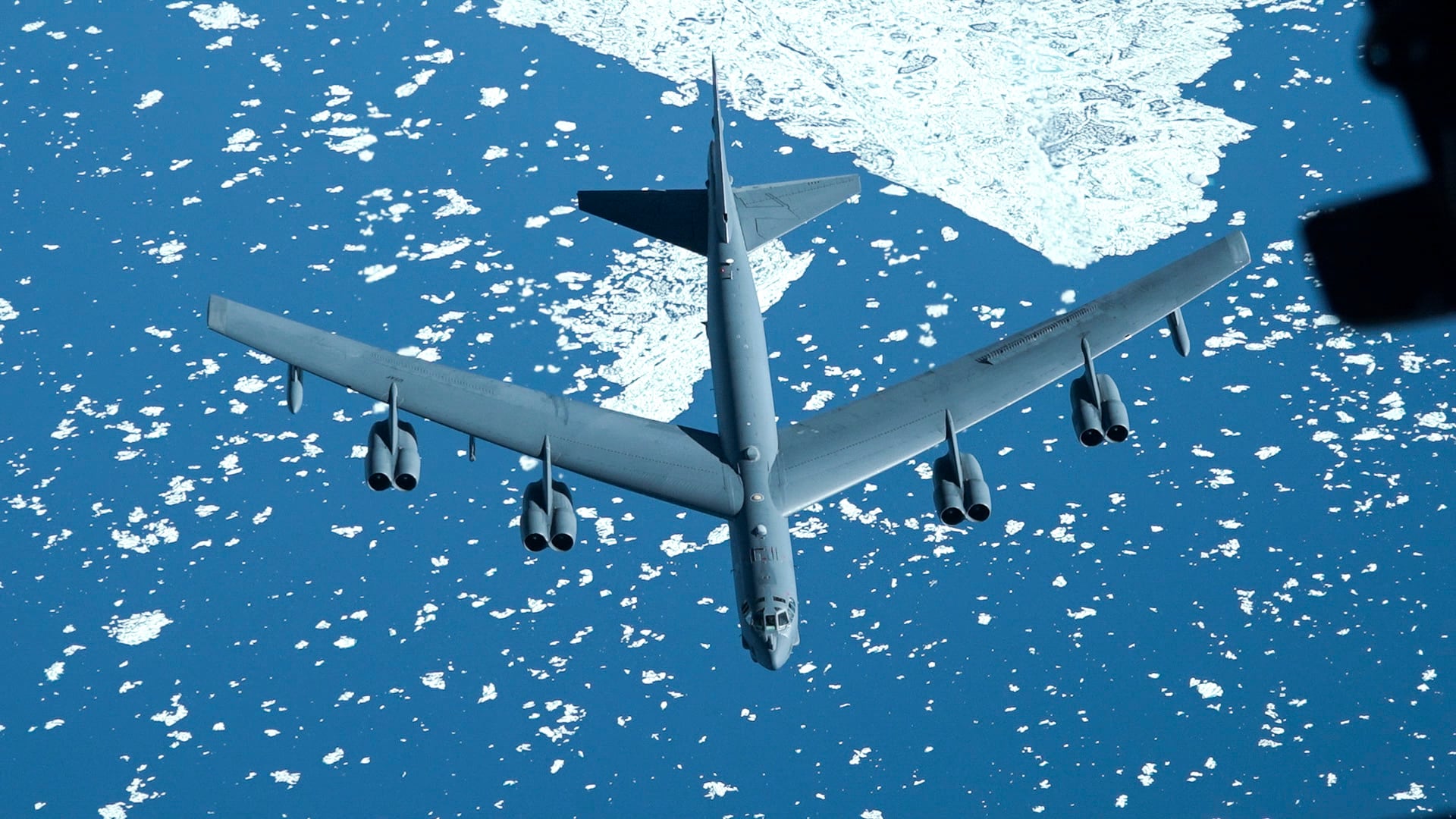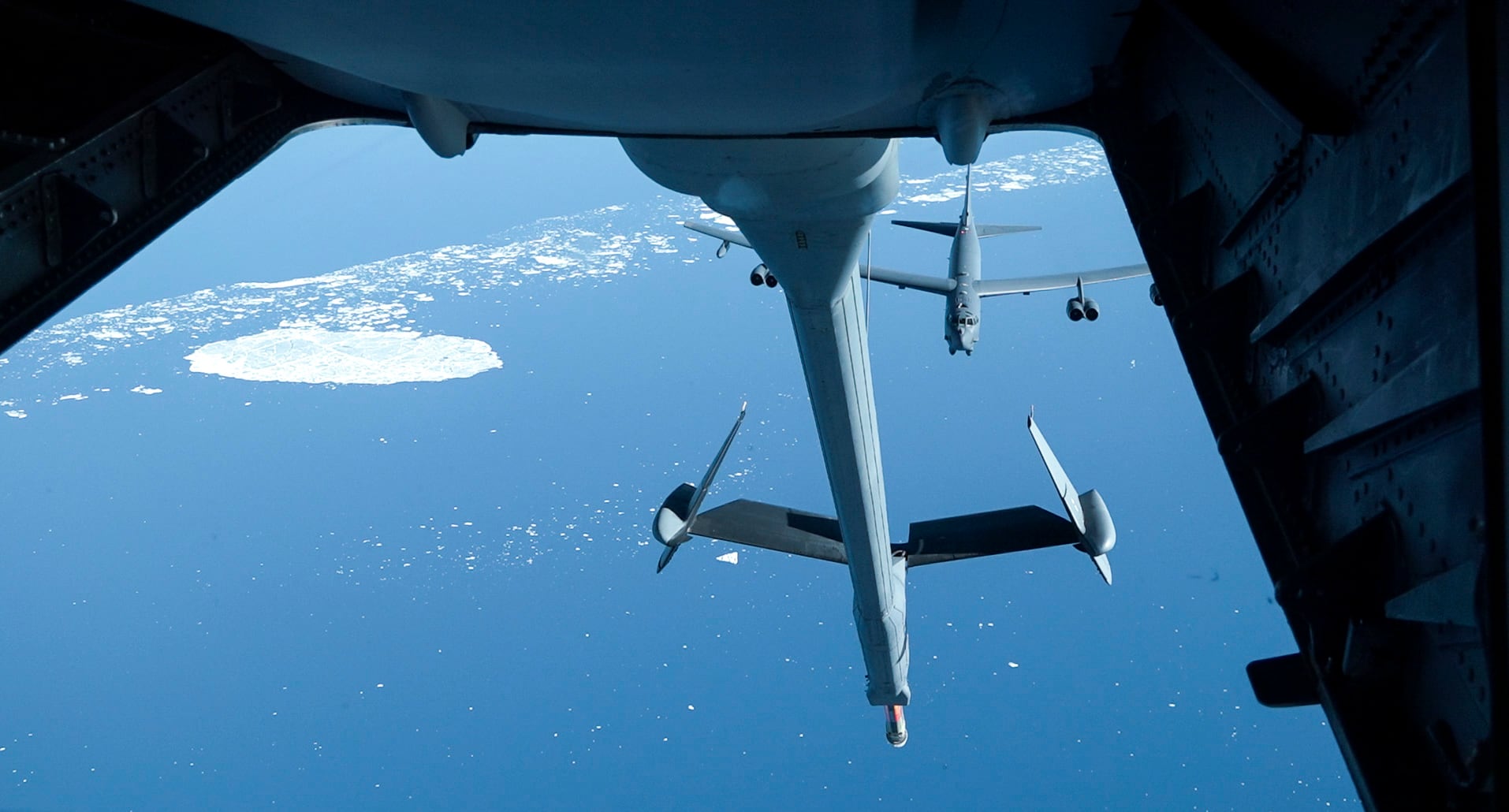THE ARCTIC -- There aren't many gas stations in the Atlantic Ocean, especially for a plane the size of a B-52. So when the nation's bomber force needs to top up, somebody has to bring the fuel to them.
On July 31st, that duty falls to the 305th Air Mobility Wing. Taking off from Joint Base McGuire-Dix-Lakehurst in southern New Jersey, four KC-10 Extender aerial refueling tankers head off on the long trek up to the Arctic to meet up with three B-52 Stratofortress taking part in a global exercise.
"It's almost like an organized chaos," says Senior Master Sergeant Mark Barnette, glancing out the window of his refueling controls to the water far below. "The Air Force has been doing air-to-air refueling for decades, but it is an organized chaos that we have mastered. You'd never get two airliners within 30 feet of each other, and we do it every day."
Refueling is a critical skill to keep aircraft flying and on mission, something pilots across the force rely upon. But just because refueling is necessary and frequent doesn't make it easy. Indeed, getting an almost 160 ft. long B-52 to attach to the boom of a more than 180 ft. long KC-10 requires a skill and precision of operation.
"Some people describe tanker air refueling as 'imagine you're going down the highway at 65 miles an hour and you come up next to another car, and are trying to basically pass a cup of coffee from one window to the next,'" said Lt. Col. Rob McAllister, with the 32nd Air Refueling Squadron. "It's that type of delicate precision that we try to do."
But on Sunday, in the clear crystal skies of the Arctic, traveling between Canada and Greenland, the aerial dance between two massive aircraft went off without a hitch.
"20 feet…15…10…," Barnette says into his headset, eyes fixed on the KC-10's refueling boom as it inches towards the receiver. With a jolt the planes connect, the KC-10 shaking slightly for an instant as the flying behemoths touch.
"Contact," Barnette calls.
It's one of thousands of aerial refuelings Barnette has conducted in his 22 year career in the service, sometimes in friendly skies and sometimes over deserts in the Middle East.
Today, his view is one of deep blue water thick with ice flows and some small ice bergs.
"Bet that water's cold," he remarks.
In the cockpit, flight engineer Senior Master Sergeant Ramiro Castro watches the dials, eyeing the numbers ticking as the fuel transfers between aircraft. McAllister looks over his shoulder, calculating how much fuel the KC-10 will have left once the refueling is done, deciding how much they have to give any other B-52s – or KC-10s – that need more.
The pilots, Captains Lane Garman and Ross Jardis, are keeping an eye on the other aircraft in the formation, watching another B-52 and KC-10 duo hook up about a mile away off to the left. They glance at their electronic tablets loaded with flight plans and mission information, getting ready to make the turn back towards home.
Today the KC-10 took off with about 280,000 lbs. of fuel on board. Over the radios, the B-52 pilots make their requests. This one needs 65,000 lbs. Another needs 50,000.
A shudder goes through the plane as the B-52 pushes on the boom.
"I don't know if you can feel it, but he's pushing us," Barnette says over the headphones.
"Oh, we can feel it," Garman confirms.
Fueling up, tens of thousands of feet in the air
Getting two aircraft to meet up for refueling is a delicate procedure where it's most important to take time and do it right.
"The two airplanes joining up together is a long process," says Barnette, also with the 32nd. "It may start as much as us being 100 miles apart. My pilots and the receiver pilots will work together to get to a point where we're in the same airspace together."
The receiver will start to close slowly, and start positioning themselves so that they're slightly below the KC-10 – right where the boom is.
"Once they get inside of half a mile is where the boom operator takes over," Barnette says. "Usually when they get inside about 50 ft. from each other, that's where me and the receiver really start to communicate with each other."
Inside of 50 ft., the receiver aircraft is closing the distance at a speed of only about a foot per second.
That's especially important, McAllister says, because of the power of some of the larger aircraft.
"It's almost like if you think about NASCAR with drafting," he says. "They have eight engines, so as they close, there's basically a bow wave. As they close that bow wave is going to want to lift up the aft tail section of the tanker. The nose is going to come down."
Autopilot controls will adjust the tanker to keep it steady, but the pilots and crews also practice refueling contacts with the autopilot turned off.
"It is a huge difference between refueling an F-16 versus a B-52 or any of these other large aircraft in terms of the dynamics, because that bow wave, it will have a greater effect on the tanker," McAllister says.
Once the aircraft are close enough, it's Barnette's job to bring the boom out to the receiver. Hands on the joystick controls, he maneuvers the boom – essentially a long metal tube – until he can connect with the refueling receptacle at the top of the other plane.
"Every receiver aircraft has two latches that will now grab the boom. They grab the boom and hold on and that's why we can move around and not come apart," Barnette says. "Once we're connected, they are holding onto my boom, it's not going to go anywhere."
During some missions, such as one during wartime, connections in the boom also allow the two aircraft to talk with each other without having to use radio transmissions that could be intercepted.
"It's very helpful if you're in a sensitive area. It's not a radio broadcast, it's secure," Barnette says.
Refueling a plane the size of a B-52 could take as long as 10 or 11 minutes, McAllister says.
"Once they were on, we were using six air refueling pumps, offloading about 7,000 lbs. a minute," he says. "As they take on the gas, as they get heavier, they're going to have to add more power. As we get lighter, then we have to reduce the power in order to not speed too far away from them."
And even larger planes take longer. A C-5 Galaxy or Super Galaxy – the largest aircraft the Air Force operates – can take on as much as 100,000 lbs. of fuel.
"The large guys that need a lot of gas, they can be on the boom for 25 minutes," Barnette says.
Still, Barnette says he considers the larger planes a little easier to refuel.
"They move around a lot slower, they come in a lot slower," he says.
Fighters, unsurprisingly, are the exact opposite.
"An F-16 is a very fast aircraft. From 50 ft. to where I need to get the contact, it may only be 10 seconds that it takes to get that distance," Barnette says. "They move once they're connected, they move around very fast…you have to be more reactive to the little ones."
When the refueling's done, Barnette hits a button. The boom separates from the receiver, and the two aircraft start to slowly move apart.
The frigid Arctic air doesn't have much of an effect on the refueling. Barnette points out that the aircraft are so high up, the temperature doesn't make any difference.
"Right now outside it's minus 30 degrees anyway," he says. "It's always cold up here, and we do just fine."
Polar Roar
In fact, practicing in the Arctic territory was part of the idea. The refueling conducted by the 305th AMW was one leg of a much larger exercise known as 'Polar Roar.'
Navy Captain Donald Kennedy, the Director of Operations for the Joint Functional Component for Global Strike, says the goal was exercising the worldwide capability of the U.S. bomber fleet and integrating with partner nations.
In addition to the three B-52s, two B-2 Spirit stealth bombers also participated in the exercise – with the 305th launching another set of KC-10s to refuel them.
There were three main parts of the exercise, Kennedy says: a trans-Atlantic flight to the Baltic Sea, the arctic trip to the North Pole and back, and a Pacific portion that saw bombers travel up the west coast of the U.S.
Kennedy estimates there were 26 separate aerial refuelings over the course of the mission.
In addition to the bombers and KC-10s, a number of smaller aircraft were involved too, such as F-22 Raptors that conducted training in Alaska.
Including the U.S., there were ten different nations that took part in the Polar Roar exercise in some form.
"I'm fairly confident that the nation will have its intended benefit of providing a robust training activity for our aircrews and providing a demonstration of a strong, incredible bomber capability," Kennedy says.
He hopes the message that airmen and other service members involved will take away from the exercise is "the importance U.S. Strategic Command places on our bomber force being ready to conduct these missions globally at a place and time of our choosing."
"We understand that we have to be able to execute these missions globally and with a broad range of coalition partners," Kennedy says. "This training in peace time is what allows us this capability in crisis."
"On the cutting edge of readiness"
For Barnette, it's about supporting the mission.
"In the tanker community, we're a cog on a gear," he says. "We're there to support everybody else. It's not about us, it's about what everybody else needs. Those fighters and those bombers need gas, and we go where they need us…That's our job. A mission like this is just fun for us. We get to go fly. This is what we train to do."
Refueling a Stratofortress is a special treat for him. As a non-commissioned officer, Barnette often lets younger airmen practice refueling the larger aircraft to gain experience. Despite conducting thousands of aerial refueling himself, today was only the third time Barnette's connected with a B-52.
"I'm getting ready to retire here soon, and I was thinking to myself, 'why did I decide to join the Air Force 22 years ago?'" he says. "And I am not 100 percent sure why I did it in the first place. I graduated high school when the first Gulf War happened. All those guys involved in that first Gulf War were going to be a part of history. There was something bigger that they were part of. If history was written, I wanted to be able to say I was part of that. I wanted to be a part of something that was bigger than me."
As the evening approaches, the KC-10s head for home.
Sitting in the cockpit, with the sun setting behind him, the polar sky dyed a deep pink, McAllister reflects on the day's activities.
"The reason we do these exercises is to make sure that we are on the cutting edge of readiness," he says. "Even though we have a lot of static forces that are deployed overseas, forward deployed, we still need to participate in these types of exercises to make sure that all the training that we do, all the fuel that we filled up, that that doesn't go away, that that doesn't become complacent."
"The more we do that, the more we are prepared," he continues. "Because you never know. You always have to be ever ready."
He glances around the cockpit.
"You're in safe hands. We're proud of what we do, we're excited for what we do, we're a huge team there at Joint Base McGuire-Dix-Lakehurst," he says. "I hope you leave saying 'wow, this is really cool what they do it and they do it with precision.'"
A few minutes later, McAllister gets on the plane's intercom and makes it official: after nearly 10 hours in the air, a trip to the top of the world, and three B-52s refueled, the KC-10s have finally returned to American airspace.

A flight of KC-10 Extender aerial refueling tankers with the 32nd Air Refueling Squadron practices refueling. Operation Arctic Roar is a U.S. Strategic Command operation designed to strengthen bomber crews' interoperability and demonstrate ability for the U.S. bomber force to provide flexible and vigilant long-range global-strike capability.
Photo Credit: Alan Lessig/Staff

A B-52 flies away from a KC-10 Extender aerial refueling tanker from the 32nd Air Refueling Squadron at Joint Base McGuire-Dix-Lakehurst in NJ, after taking on fuel while flying over international airspace between Greenland and Canada in the arctic on Sunday, July 31, 2016. This was part of Operation Arctic Roar, a U.S. Strategic Command operation designed to strengthen bomber crews' interoperability and demonstrate ability for the U.S. bomber force to provide flexible and vigilant long-range global-strike capability. On the return flight, the flight of 4 KC-10's practiced refueling between the tanker planes. (Alan Lessig/Staff)
Photo Credit: Alan Lessig, Air Force Times

A B-52 flies away from a KC-10 Extender aerial refueling tanker from the 32nd Air Refueling Squadron at Joint Base McGuire-Dix-Lakehurst in NJ, after taking on fuel while flying over international airspace between Greenland and Canada in the arctic on Sunday, July 31, 2016. This was part of Operation Arctic Roar, a U.S. Strategic Command operation designed to strengthen bomber crews' interoperability and demonstrate ability for the U.S. bomber force to provide flexible and vigilant long-range global-strike capability. On the return flight, the flight of 4 KC-10's practiced refueling between the tanker planes. (Alan Lessig/Staff)
Photo Credit: Alan Lessig, Air Force Times

A B-52 flies away from a KC-10 Extender aerial refueling tanker from the 32nd Air Refueling Squadron at Joint Base McGuire-Dix-Lakehurst in NJ, after taking on fuel while flying over international airspace between Greenland and Canada in the arctic on Sunday, July 31, 2016. This was part of Operation Arctic Roar, a U.S. Strategic Command operation designed to strengthen bomber crews' interoperability and demonstrate ability for the U.S. bomber force to provide flexible and vigilant long-range global-strike capability. On the return flight, the flight of 4 KC-10's practiced refueling between the tanker planes. (Alan Lessig/Staff)
Photo Credit: Alan Lessig, Air Force Times

A B-52 dives away from a KC-10 Extender aerial refueling tanker after taking on fuel. On the return flight, the flight of 4 KC-10's practiced refueling between the tanker planes.
Photo Credit: Alan Lessig/Staff

A B-52 slowly pulls up to the boom of a KC-10 Extender aerial refueling tanker . Inside of 50 feet, the receiver aircraft is closing the distance at a speed of only about a foot per second.
Photo Credit: Alan Lessig, Air Force Times

A KC-10 Extender aerial refueling tanker with the 32nd Air Refueling Squadron at Joint Base McGuire-Dix-Lakehurst, N.J., refuels an Air Force B-52 bomber while flying over international airspace between Greenland and Canada in the arctic on July 31.
Photo Credit: Alan Lessig/Staff





